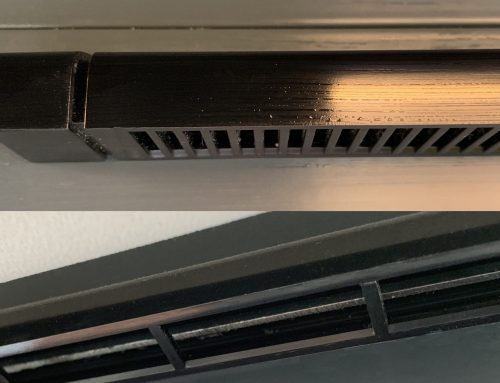Have you noticed condensation on the outside of your aluminium double glazed windows?
When you have new double glazing installed in your aluminium windows or doors, the double glazing acts as insulation. It prevents or slows down the loss of heat through the glass in the windows. Modern double glazing has improved thermal properties over old glazing and the void between the glass panels is filled with gas to improve these qualities. You can purchase glazing that offers different characteristics for different applications – to reduce noise, reduce the level of UV rays, improve thermal qualities and many more properties too.
Where cold air meets a warm surface, condensation will normally occur.
If you have old windows the glass is cold inside, the warm air from inside a house meets the cold surface of the aluminium window and condensation occurs inside the property. You will see properties with the moisture running down the inside of the window and onto the window ledge. (does it bring back memories of your childhood or student days!) Without any ventilation damp will occur. This is not a healthy environment for the occupant.
When new double glazing has been installed the pains of glass and void in between act as a thermal barrier. The warmer surface is now on the outside of the property, so when it meets with the cold outside air it condenses on the outside of the glass. In late September when the temperature outside is dropping lower overnight, we put on our heating and in the morning can see the condensation on the outside of the window.
The condensation on the outside of the glass shows that the double glazing is acting effectively at keeping the warm air in and the cold air out.
The heat is being retained and hopefully you will soon see the difference in your heating bill. Replacing the glass means that whilst you may not be able to see the difference you will clearly feel the difference.
Condensation on the outside of a double glazed window occurs when the surface temperature of the glass falls below the dew point temperature of the surrounding air. This phenomenon is known as “external condensation.” While it might seem counterintuitive, there are scientific reasons behind this occurrence:
1. Temperature Differential
External condensation usually occurs during specific weather conditions. If the outdoor air is cooler and has a higher relative humidity, and the glass surface temperature is lower than the dew point of that outdoor air, moisture from the air can condense on the exterior surface of the glass.
2. Effective Insulation:
Double glazed windows are designed to provide effective insulation by trapping a layer of air or inert gas between two glass panes. This insulation helps prevent heat transfer between the interior and exterior of a building. When the windows are very efficient at insulating, they can prevent heat from transferring to the outer pane, causing the outer glass surface to remain cooler than the surrounding air.
3. Clear Night Sky:
On clear nights, heat radiation from the Earth’s surface can escape into the night sky. This radiation cooling can cause the exterior surface of the glass to cool down, leading to a temperature drop below the dew point of the humid air.
4. Reduced Wind:
Wind can have a warming effect on surfaces. On calm nights or in sheltered areas, the absence of wind allows surfaces to cool more, potentially leading to condensation.
It’s important to note that external condensation is not a sign of a faulty window but rather a consequence of the interaction between temperature, humidity, and the insulating properties of double glazed windows. While it might be a temporary phenomenon, it’s generally an indication that the window is effectively insulating the indoor environment from the outdoor temperatures.
It’s also worth mentioning that external condensation typically occurs in specific weather conditions and is temporary. As the environmental conditions change, such as when the outdoor temperature rises or humidity decreases, the condensation will usually dissipate.






Leave A Comment
You must be logged in to post a comment.